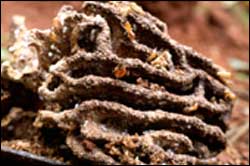Fungus-farming termites descend from an African rain forest Eve

Agriculture is not unique to humans: some insect groups have also evolved this way of life. One such group is the fungus-farming termites, which cultivate fungi as food inside their nests. Such termites can be found in both rain forest and savannah habitats in the Old World tropics, from Africa to Asia. But as researchers report this week, a combination of DNA sequence analysis and computer modelling suggests that termite agriculture originated in the African rain forest, and gave rise to the many fungus-cultivating termite species alive today in various parts of the Old World.
The relationship between the termites and the cultivated fungus represents an impressive example of mutualistic symbiosis. The termites use chewed plant material, such as wood and dry grass, to feed the fungus and allow it to flourish, while the fungus converts otherwise indigestible plant material into nutrients the termites can utilize. Earlier work had shown that in the evolutionary past, a single, unreversed, transition to agriculture occurred in which termites domesticated a single lineage of fungi, represented today by the genus Termitomyces, a white rot fungus. These fungi are some of the few organisms that can digest the plant component lignin. Within the termite colonies, which can grow very large, the fungus grows on a special structure called the comb, which is maintained by the termites by the continual addition of new plant material.
Researchers Duur Aanen (University of Copenhagen) and Paul Eggleton (The Natural History Museum London), having sampled 58 colonies of fungus-cultivating termites (representing 49 species) in Senegal, Cameroon, Gabon, Kenya, South Africa, Madagascar, India, Sri Lanka, Thailand and Malaysian Borneo, now provide strong evidence that termite agriculture originated in African rain forest. Their reconstruction of ancestral habitats is based on the habitat of living species and analysis of DNA-based reconstructions of termite relationships.
The rain forest origin of fungus-growing termites is remarkable, as extant species of fungus-growing termites are ecologically (in terms of their relative contribution to decomposition processes) and evolutionarily (in terms of species numbers) most successful in savannah ecosystems. The researchers hypothesize that the ecological success of fungus-growing termites in savannas is due to the adoption of a highly successful rain forest process (fungal white-rot decay) by domesticating white-rot fungi. By offering those domesticated fungi a constant supply of growth substrate, and humid, highly buffered, rain forest like climatic conditions in their nests, termites have been able to export this rain forest process into the savannas. The marrying of termites and fungi in a mutualistic symbiosis has thus allowed both partners to conquer the savannah: agricultural termites and their mutualistic fungi are both more successful in this habitat than each of their non-agricultural sister groups, which thrive in the rain forest.
Interestingly, those results have some parallels to the origin and subsequent evolution of human agriculture. Human agriculture is also believed to have originated in relatively favourable areas to which most domesticable plants and animals were native. From the homelands of domestication, agriculture has later spread to other regions, including to much more unfavourable areas. This occurred either by the adoption of an agricultural lifestyle by local hunter-gatherers, or, and probably more often, through replacement of local hunter-gatherers by farmers. The agricultural lifestyle has allowed both humans and their domesticated organisms to exploit unfavourable areas more effectively and to reach far higher population densities than each of their non-agricultural relatives can alone. Furthermore, besides their agricultural proficiency, fungus-farming termites resemble humans in another respect: just like the human female ancestor was African, so was the ’Eve’ of fungus-growing termites, and just as humans later migrated out of Africa, so have fungus-farming termites. Evidence suggests they have colonised Asia at least four times.
Media Contact
All latest news from the category: Life Sciences and Chemistry
Articles and reports from the Life Sciences and chemistry area deal with applied and basic research into modern biology, chemistry and human medicine.
Valuable information can be found on a range of life sciences fields including bacteriology, biochemistry, bionics, bioinformatics, biophysics, biotechnology, genetics, geobotany, human biology, marine biology, microbiology, molecular biology, cellular biology, zoology, bioinorganic chemistry, microchemistry and environmental chemistry.
Newest articles

Properties of new materials for microchips
… can now be measured well. Reseachers of Delft University of Technology demonstrated measuring performance properties of ultrathin silicon membranes. Making ever smaller and more powerful chips requires new ultrathin…

Floating solar’s potential
… to support sustainable development by addressing climate, water, and energy goals holistically. A new study published this week in Nature Energy raises the potential for floating solar photovoltaics (FPV)…

Skyrmions move at record speeds
… a step towards the computing of the future. An international research team led by scientists from the CNRS1 has discovered that the magnetic nanobubbles2 known as skyrmions can be…





















